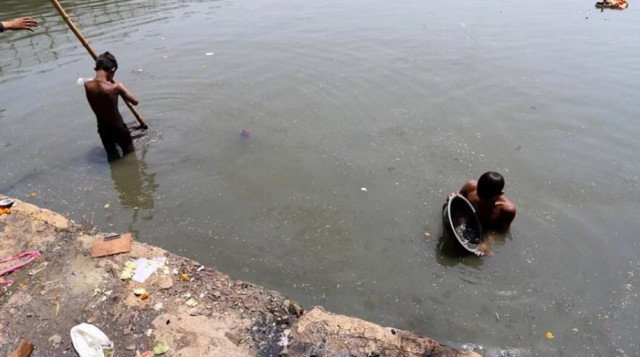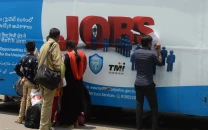Who are the people risking their lives on India’s ‘dirtiest job’?
Sewer cleaners die every year in India but caste-based discrimination means their suffering remains largely ignored

In the sweltering heat of New Delhi, India’s capital, Karam Bir, 38, seeks respite under a tree as he checks his phone, hoping for a call that would bring him some desperately needed work.
A sewer cleaner, Bir has been out of work for the past few days, making him anxious about how he can put food on the table for his family.
“I am out every day looking for work. I get on my bicycle and leave the house early in the morning,” he told Anadolu.
“I get some work after every few days. Sometimes my friends give me a call to let me know if something comes up.”
For the past two decades, Bir has been cleaning sewers and septic tanks with his bare hands, a hazardous and often deadly task referred to as manual scavenging.
Sewer cleaners, or sanitation workers, like Bir enter drains to clean out blockages and any other waste by hand, often waist-deep in a noxious mix of sludge, feces, and poisonous gases.
Legally, the practice has been outlawed in India since 2013 under the Prohibition of Employment as Manual Scavengers and their Rehabilitation Act.
However, recent surveys found there were more than 58,000 manual scavengers in India between 2013 and 2018, according to the Social Justice and Empowerment Ministry.
The fatality figures are also alarmingly high. The government maintains that there are no deaths directly due to manual scavenging, but its figures show 308 workers died in just the past five years due to “hazardous cleaning of sewers and septic tanks.”
The latest were as recent as March, when two people who were working without any safety gear died in the western state of Gujarat.
‘No other option’
Despite the risks, those engaged in this work, like Bir, say they have little choice.
“I started doing this to feed my family. I know it’s dangerous, but I have no other option,” said Bir, a father of five.
“My father was also in the same line of work. I saw how it affected him and how ill he fell because of the toxic gases.”
Bir moved to New Delhi from his hometown in the neighboring state of Haryana, one of the millions of Indians who look to the sprawling capital for economic opportunities.
“Life is tough. There is hardly any sense of security. Anything can happen to me any day, and my family will be left behind to suffer,” he said.
“My brothers, my father, and I never got an education. But I don’t want my kids to have the same fate. I just want to make sure that they get a good education and have a brighter future.”
Surinder Kumar, another sanitation worker in the capital, has a similar story. The only difference is that he is the first from his family to take up the job.
“I was desperate for a job. There was nothing for me, so this is where I ended up,” he said.
Kumar, 39, is also well aware of the perils of the job.
“Sometimes you have to live with the risks and danger. I came to Delhi to earn, I can’t just sit at home and do nothing,” he said.
The one thing that Kumar does want is more government attention and efforts for safety of sanitation workers.
“There has to be a proper plan,” he said.
Caste and apathy
Bezwada Wilson, an activist working on the issue, does not have much hope from the government.
The reason for his skepticism lies in India’s deeply entrenched caste system, which is among the world’s oldest social stratification model.
At the very lowest rung of India’s caste pyramid lie the Dalits, or the untouchables, who have suffered the most – and continue to – because of their perceived lower societal status.
For centuries, the Dalits have been consigned to jobs considered demeaning, such as cleaning latrines and sewers or sweeping roads.
Also read: Despite world-beating growth, India's lack of jobs threatens its young
“Manual scavenging is rooted in the caste system and the government is not doing much to end it,” Wilson, who heads the Safai Karmachari Andolan, or Sanitation Workers’ Movement, told Anadolu.
“Sewage workers die regularly in India, but the central and state governments are not taking a single step to prevent these deaths, simply because the workers are Dalits.”
If anything, Dalits are marginalized from society and pushed to do what is considered the “dirtiest job,” he said.
According to the last census in India over a decade ago, there were 200 million Dalits in the country, making up more than 16% of the over 1.3 billion population.
Given the rampant discrimination against Dalits, it is little wonder that the suffering of sewer cleaners and their families does not end even in death.
If a worker dies on the job, the process of getting compensation from the government is excruciatingly tedious for their family.
That was the case for Shama Gusiyun, whose husband died while trying to clean a choked drain in 2011.
After more than 12 years, she received 1 million Indian rupees (around $12,000) from the government just this year.
“It was a long, long struggle,” Gusiyun, a mother of two, told Anadolu.
“I was expecting that the government would also give employment to a family member so that we can have some sense of security for our children. I’ve finally got the money, but there is no job. The government has to do more to help families like us.”
Mechanization and rehabilitation
The government, however, claims it does have a plan.
It touts the National Action for Mechanized Sanitation Ecosystem as a solution to the issue, saying that the scheme aims to identify manual scavengers in India and assist in their rehabilitation.
According to the document, the scheme will prevent deaths and “promote mechanization of cleaning operations with a vision to reduce hazardous cleaning and ensure the safety of sanitation workers.”
An Indian parliamentary committee report last year hailed the plan’s potential impact, but pointed out that it has done little in terms of actually saving lives.
The committee members said they “are surprised to note that despite all these measures, deaths of persons while cleaning sewer and septic tanks continues even today.”
Activists like Wilson believe that there are solutions, but all of them require strict implementation and serious will.
“You can mechanize the system. No human being will have to enter sewers and septic tanks. We do have the technology; adopt it and ensure proper mechanization,” he said.
“However, we also need a proper package for the rehabilitation of these workers,” he added, underlining that any plans made so far have faltered when it actually came down to implementation.



















COMMENTS
Comments are moderated and generally will be posted if they are on-topic and not abusive.
For more information, please see our Comments FAQ